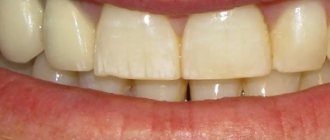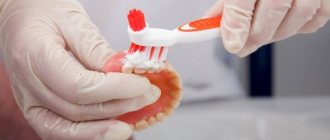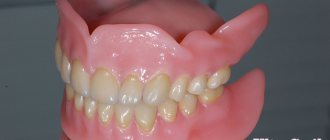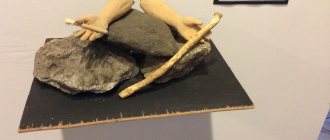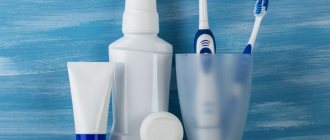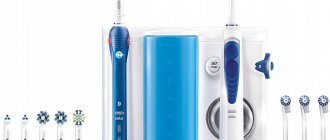Ksenia Kotova editor of Dental Magazine
From time immemorial, humanity has been concerned about oral hygiene. Studying the remains of teeth that are 1.8 million years old, archaeologists have determined that the small dimple-shaped depressions on them are the result of the impact of a primitive toothbrush. Originally it was just a tuft of grass that people used to rub their teeth to get rid of stuck food fibers. Over time, a tool for cleaning teeth has become not only a hygiene item, but also an indicator of the status of the owner. For example, in Japan, China and Ancient India it was made from precious metals.
It is known that in ancient times people used salt, chalk or soot and rubbed them into their teeth using their fingers or a piece of cloth.
Already in 3500 BC. e. the inhabitants of Babylon, Greece and Rome made special chewing sticks from fragrant branches of the mastic tree. The twig was chewed from one end, leaving a pointed edge and using it as a toothpick.
Rice. 1. Chewable licorice root stick.
In ancient India, teeth were cleaned with a mixture of charcoal, gypsum, resin and roots of medicinal plants. In India, chewing twigs made from the branches of the neem tree are still sold.
Rice. 2. A stick for cleaning teeth made from neem tree branches.
The Egyptians, and especially noble nobles, whitened their teeth enamel with powder made from raisins, myrrh and frankincense. Crushed ram's horn was used as an abrasive.
The toothbrush has come a long way since its inception, and the history of its development is fascinating and amazing!
Researchers believe that dental instruments similar to those used around the world today were invented in China in 1498. Its bristles were stiff and consisted of coarse hairs taken from the back of the pig's neck. The handles to which the bristles were attached were made of bones or bamboo.
Rice. 3. China is considered the birthplace of the toothbrush.
In Russia in the 16th century, similar “tooth whisks” were also known, consisting of a wooden stick and a brush made of pork bristles. These inventions were delivered to Russia from Europe.
Rice. 4. The “toothbrush” accompanied every self-respecting boyar at royal feasts.
Under Peter I, the royal decree ordered that the toothbrush be replaced with a cloth and a pinch of crushed chalk. In the villages they continued to rub their teeth with birch charcoal, which whitened the teeth.
The very first toothbrush: what was it like?
In this article
- The very first toothbrush: what was it like?
- When did toothbrushes become popular?
- In what year was the modern brush invented?
- The first electric toothbrush: when did it appear?
- Modern models: variety of choice
People have been thinking about oral hygiene long before there was a toothbrush. This is confirmed by archaeological excavations, during which numerous devices for cleaning teeth were found. For example, one such device was a wooden stick, one edge of which was pointed, and the other was used for chewing to remove plaque. These “brushes” were made from trees rich in essential oils.
The first toothbrushes were twigs, tufts of grass, bird feathers, animal bones and even porcupine quills.
Types and classification
The modern market offers a wide range of products for cleaning the oral cavity. It’s easy for a buyer to get lost in the variety of toothbrushes.
Getting to know the most popular types of toothbrushes, their advantages and disadvantages will allow consumers to make the right decision and choose the most suitable device for cleaning the oral cavity.
Read about arthritis of the maxillofacial joint and its symptoms and treatment with antibiotics. What ointment to use when treating gums? More details here.
Bamboo
Bamboo toothbrushes are usually classified as environmental products. The bristles of the device are made of natural bamboo fiber.
Unlike toothbrushes made of nylon fibers, the bamboo analogue boasts the finest bristles coated with substances to prevent diseases and improve the general condition of the oral cavity.
Bamboo toothbrushes have several obvious benefits. Among them are the following:
- Gentle care. Bamboo toothbrushes are an alternative solution for people with sensitivity. The device gently and effectively cleanses the oral cavity.
- Disinfectant properties. Bamboo has powerful disinfectant properties; the plant is included in many Chinese medicines.
- Hypoallergenic. The toothbrush is suitable for small children and people with allergies. Moreover, a bamboo brush can be used without toothpaste.
- Variability. Manufacturers offer bamboo brushes with additional coating on the fibers, which have beneficial properties.
Note . Gold spraying has an anti-inflammatory effect, silver particles have an antibacterial effect, charcoal spraying whitens teeth and eliminates unpleasant odors, and jade actively fights tartar.
However, users of bamboo oral toothbrushes note minor disadvantages of the device. We are talking about the primitive design and excessive flexibility of the device handle.
Electrical
Many users, when choosing an oral care product, prefer the most interesting new products from manufacturers, for example, an electric toothbrush.
Unlike classic toothbrushes, the electric device is equipped with a special head, which automatically performs rotational movements, eliminating plaque, food debris and harmful microorganisms.
Note . Electric toothbrushes produce up to 48 thousand strokes per minute.
Electric toothbrushes have a number of winning advantages. Among them are the following:
- Save time. When using a regular toothbrush, the procedure for cleaning the oral cavity takes up to 5 minutes, while an electric device copes with the task within 2 minutes.
- Efficiency. Electric oral cleansers are more effective at removing plaque and bacteria from the surface of teeth. According to a Cochrane study, using an electric toothbrush reduced gingivitis bacteria by 12% over two months.
- Safety. Electronic toothbrushes are equipped with a special sensor that controls the force of pressure on the surface of the teeth. The technology allows you to minimize the abrasion of enamel and damage to the gums.
As for the disadvantages, buyers note the fairly high cost of the toothbrush and the need to regularly charge oral care devices.
At the same time, experts note that an electric toothbrush is contraindicated for users wearing veneers or crowns. Vibrations of the device contribute to micro-destruction of prostheses.
Ultrasonic
Just a few years ago, it was difficult for people to imagine an ultrasonic toothbrush for cleaning the oral cavity. But progress does not stand still, and modern manufacturers are actively producing nano-brush.
The principle of operation of the device is simple; the toothbrush fights plaque and bacteria even in hard-to-reach places thanks to ultrasound radiation, inaccessible to human hearing. The bristles of the device are capable of producing up to 100 million rotations per minute.
The main advantage of the ultrasonic novelty is its high efficiency. Ultrasound performs its functions much more effectively than the components of toothpastes; the device reduces gum bleeding and has an antimicrobial effect.
Among the disadvantages of an ultrasonic toothbrush, it is necessary to note its cost, which is several times higher than the prices of other types of devices for cleaning the oral cavity. Moreover, the device is contraindicated during pregnancy and lactation.
When did toothbrushes become popular?
At the end of the 15th century, the Chinese invented a device that was much more like a modern toothbrush. It looked like a bamboo stalk with the stiff bristles of a wild boar attached to it. The toothbrush was used dry - without paste or powder.
Gradually, the invention of the Chinese began to spread throughout the world and even reached our country. During the time of Ivan the Terrible, dental brooms were popular, which looked like a wooden stick with bristles at the end.
In the mid-17th century, a book by the French dentist Pierre Fauchard appeared, which described dental diseases and methods for their removal. In his book, the dentist recommended brushing your teeth daily, which contributed to the rise in popularity of the toothbrush.
Toothbrush hardness levels for the oral cavity
When choosing a toothbrush, you need to pay attention to the degree of stiffness of the bristles.
In general, experts distinguish between five levels of hardness of oral care devices:
- Sensitive – the softest type of bristles. The device is intended for children or adults suffering from diseases of the gums and hard dental tissues.
- Soft – a soft toothbrush, recommended for bleeding gums, pregnant women and users with diabetes.
- Medium – a toothbrush with a medium degree of hardness. The most popular device among adults without obvious signs of oral disease.
- Hard – a device with hard bristles, which is an alternative solution for smokers and users with increased formation of dental plaque of various etiologies.
- Extra-hard – marking of a specialized toothbrush that is used to clean dentures, braces and other fixed structures in the oral cavity
In what year was the modern brush invented?
The very first modern brush appeared in 1780. It was then that the Englishman William Addis began the industrial production of these hygiene products.
The very first brushes had natural bristles, which did not dry well and contributed to the growth of bacteria.
The world really began to use toothbrushes en masse when a brush with nylon bristles appeared. It dried quickly, accumulated bacteria much more slowly than natural ones, and was lightweight and durable, due to which it quickly gained popularity. Oral-B was the very first nylon model.
Initially, ordinary nylon was used for production, which severely scratched teeth and gums, but soon a special “soft” nylon was developed, and the toothbrush became much more comfortable to use.
The first electric toothbrush: when did it appear?
The nylon toothbrush continued its evolution into the 20th century. So, at the end of the 30s, the first electric brush was invented in Switzerland, which worked from the mains. Mass production of electric brushes began in 1960 with the release of the Broxodent model. The manufacturer, the pharmaceutical company Bristol-Myers Squibb, positioned it as a hygiene product for “special” situations. It was planned that the brush would be used by people with impaired motor skills and those who wear braces.
But the device turned out to be so popular and effective that a year later the General Electrics company released a battery-powered model for mass use, and everyone began to use electric brushes.
The history of the toothbrush and toothpaste
The history of the toothbrush
The first predecessors of the toothbrush appeared back in 3500-3000. BC e. These were tree branches with a frayed end, which the inhabitants of Babylon and Ancient Egypt used to clean their teeth. Such “dental sticks” were discovered by archaeologists in the tombs of Egyptian pharaohs. Around 1600 BC. e. The Chinese began making chewing sticks from fragrant tree branches to freshen their breath.
It is believed that the first real toothbrush with natural bristles was invented in the 15th century in China. The instrument was a handle made of bone or bamboo, on which bristles, cut from the scruff of a boar, were attached. When the Asian innovation reached Europe, its design changed slightly: instead of rough pig bristles, softer horsehair or bird feathers were used.
A toothbrush, similar in design to modern dentifrice, was created by Englishman William Addis around 1780. He drilled holes in a piece of cow bone and threaded tufts of pig bristles through them, securing them with glue. More than half a century later, in 1844, the first toothbrush with three-row bristles was introduced.
The transition from natural bristles to artificial fibers in the production of toothbrushes became possible only in the 1930s, when nylon was invented in the laboratories of the American chemical company DuPont. The first toothbrush with nylon bristles appeared in 1938. Despite the tangible benefits, the new brushes remained quite harsh until production technology was improved in 1950 and the hairs became softer.
The first electric toothbrush was created back in 1939, but mass production of electric brushes began only in 1960 with the release of the Broxodent model.
These days, there is a wide range of mechanical and electric toothbrushes on the market to suit every taste. Modern samples have straight or curved plastic handles with a soft rubberized surface, making them so easy and comfortable to hold in your hand. Fibers are typically made from synthetic fibers and vary in firmness. Toothbrush heads also vary in size and shape, from miniature ones for babies to larger ones for older children and adults, from rectangular and oblong to oval and almost round.
And although the general design of a toothbrush has remained virtually unchanged since ancient times, thanks to the constant development of technology, a simple stick with bristles has turned into a modern, ergonomic and safe tool that has incorporated the latest advances in science.
The history of toothpaste
Historians believe that as early as 5000 BC. e. The ancient Egyptians used special mixtures to clean their teeth. It is known that the ancient Greeks and Romans also used cleaning powder, but it appeared in China and India only in 500 BC. e.
Ancient prototypes of toothpastes performed the same functions as their modern counterparts: they kept the mouth clean, whitened teeth, and freshened breath. However, the ingredients of ancient tooth powders were completely different. The Egyptians made them from the ashes left after burning ox hooves, ground burnt eggshells and pumice. The Greeks and Romans included polishing and abrasive substances in the mixture, such as crushed bones and oyster shells, as well as ash and plant roots. In addition, various flavorings were often used as ingredients, which improved the taste of the powder and helped get rid of bad breath. Residents of Ancient China made toothpaste from many different ingredients, including ginseng, mint and salt.
More than a century passed before toothpaste acquired its familiar form. The appearance of more or less modern samples of dental mixtures dates back to the beginning of the 19th century. Many of them contained soap. In the 1800s, betel nut was added to tooth powder in England. Recipes from the 1850s mention chalk among other ingredients, and an encyclopedia from the 1860s tells how to make homemade toothpaste using ground charcoal.
Until the mid-19th century, dentifrices were sold primarily in powder form. In the 1850s, the first toothpaste came in a jar called Crème Dentifrice. In 1873, Colgate began mass producing toothpaste in cans, and in the 1890s, the first Colgate toothpaste was introduced in a tube, like those familiar to each of us.
Until 1945, most toothpastes contained soap, which later gave way to sodium lauryl sulfate. This substance, which gives the paste a smooth and uniform texture, is still a popular ingredient in modern hygiene products.
In the second half of the 20th century, toothpastes began to appear designed to prevent various oral diseases and relieve symptoms such as tooth sensitivity. Fluoride-containing toothpastes for protection against caries have become especially popular, the first examples of which were created in 1914. Toothpastes with low abrasiveness were also invented to avoid damage to the enamel from overzealous brushing.
Today, toothpastes may contain fluorides, dyes, flavors, sweeteners, as well as ingredients that make the toothpaste smooth and foamy and prevent it from drying out. Toothpaste in tubes is still used all over the world, remaining one of the most useful inventions.
Modern models: variety of choice
Modern people have access to both traditional and electric brushes. Recent ones are becoming more advanced and technologically advanced every year. Modern models clean teeth using sound and ultrasonic waves, allow you to adjust the degree of pressure, operate in several modes, and are equipped with a built-in timer to control the cleaning time.
Dentists note that an electric brush can remove more plaque and make it easier to clean hard-to-reach areas. In addition, the use of the device increases the duration of cleaning, which has a positive effect on its quality.
If you are unsure which brush to choose for daily use, you should consult your dentist. The doctor will check the condition of your teeth and gums and assess whether they can provide effective and safe care.
